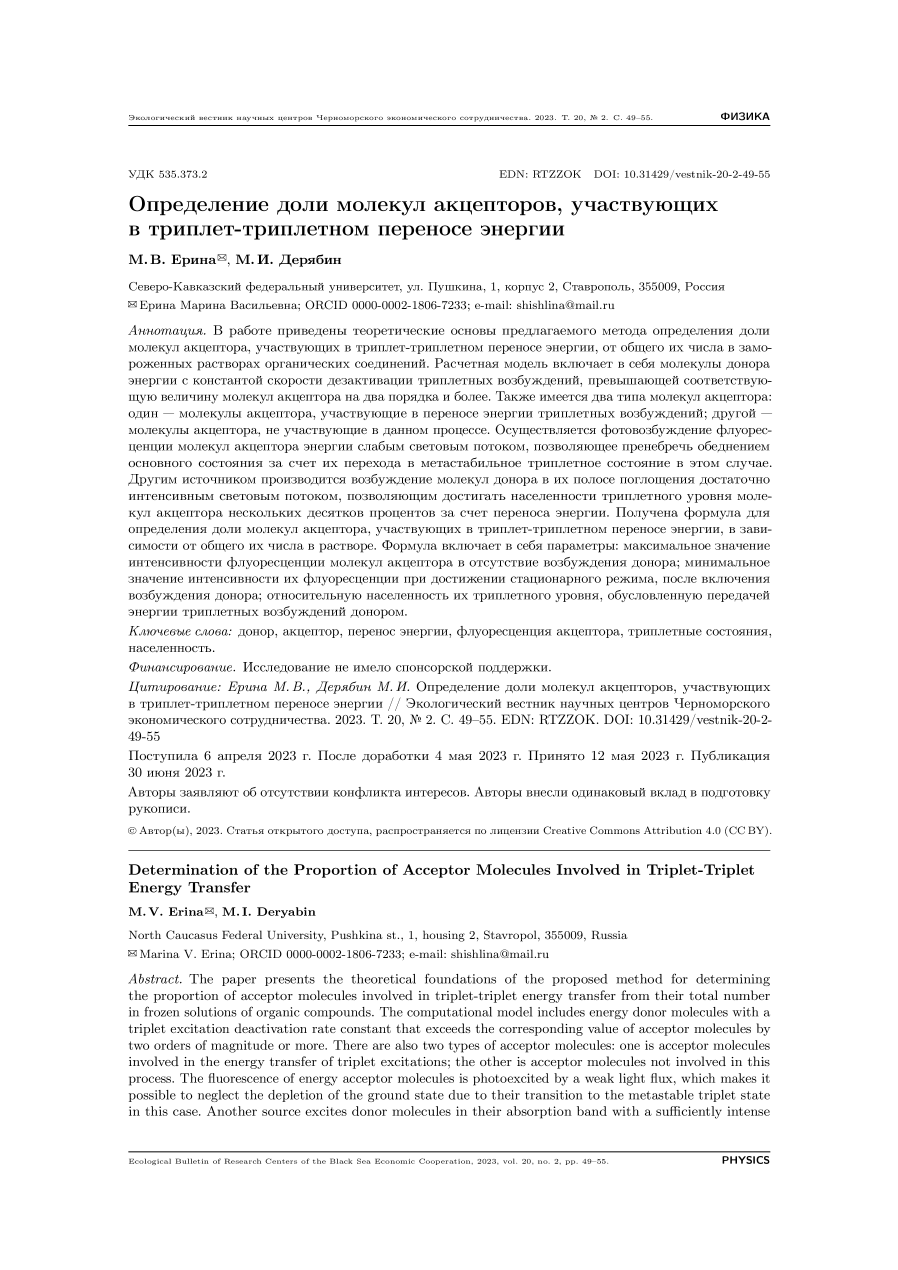Determination of the proportion of acceptor molecules involved in triplet-triplet energy transfer
UDC
535.373.2DOI:
https://doi.org/10.31429/vestnik-20-2-49-55Abstract
The paper presents the theoretical foundations of the proposed method for determining the proportion of acceptor molecules involved in triplet-triplet energy transfer from their total number in frozen solutions of organic compounds. The computational model includes energy donor molecules with a triplet excitation deactivation rate constant that exceeds the corresponding value of acceptor molecules by two orders of magnitude or more. There are also two types of acceptor molecules: one is acceptor molecules involved in the energy transfer of triplet excitations; the other is acceptor molecules not involved in this process. The fluorescence of energy acceptor molecules is photoexcited by a weak light flux, which makes it possible to neglect the depletion of the ground state due to their transition to the metastable triplet state in this case. Another source excites donor molecules in their absorption band with a sufficiently intense light flux, which makes it possible to reach a population of the triplet level of acceptor molecules of several tens of percent due to energy transfer. A formula for determining the proportion of acceptor molecules involved in the triplet-triplet energy transfer, depending on their total number in solution, is obtained. The formula includes the following parameters: the maximum value of the fluorescence intensity of the acceptor molecules in the absence of donor excitation; the minimum value of the intensity of their fluorescence upon reaching the stationary regime, after switching on the excitation of the donor; the relative population of their triplet level due to the transfer of the energy of triplet excitations by the donor.
Keywords:
donor, acceptor, energy transfer, acceptor fluorescence, triplet states, populationAcknowledgement
References
- Мак-Глинн, С., Адзуми, Т., Киносита М., Молекулярная спектроскопия триплетного состояния. Мир, Москва, 1972. [Mac-Glinn, S., Adzumi, T., Kinosita, M., Molecular Spectroscopy of the Triplet State, Prentice-Hall, 1969.]
- Сташевский, И.В., Арабей, С.М., Чернявский, В.А., Соловьев, К.Н., Характеризация Т1-состояния молекул порфиринов на основе численного моделирования кинетики уменьшения и возрастания интенсивности флуоресценции. Оптика и спектроскопия, 2016, т. 21, № 5, с. 770–777. [Stanishevsky, I.V., Arabei, S.M., Chernyavskii, V.A., Solovyev, K.N., Characterization of the T1 State of Porphyrin molecules on the basis of numerical modeling of decrease and increase of fluorescence intensity kinetics. Optika i spektroskopiya = Optics and Spectroscopy, 2016, vol. 121, no. 5, pp. 722–728. (In Russian)]
- Ермолаев, В.Л., Бодунов, Е.Н., Свешникова, Е.Б., Шахвердов, Т.А., Безызлучательный перенос энергии электронного возбуждения. Наука, Москва, 1978. [Ermolaev, V.L., Bodunov, E.N., Sveshnikova, E.B., Shahverdov, T.A., Bezyzluchatel'nyj perenos energii elektronnogo vozbuzhdeniya = Radiative energy transfer of electronic excitation. Nauka, Moscow, 1977. (In Russian)]
- Алфимов, М.В., Бубен, Н.Я., Приступа, А.И., Шамшев, В.Н., Определение концентрации органических молекул в триплетном состоянии при возбуждении быстрыми электронами. Оптика и спектроскопия, 1966, т. 20, № 3, с. 424–426. [Alfimov, M.V., Buben, N.Ya., Pristupa, A.I., Shamshev, V.N., Opredelenie koncentracii organicheskih molekul v tripletnom sostoyanii pri vozbuzhdenii bystrymi elektronami. Optika i spektroskopiya = Optics and Spectroscopy, 1966, vol. 20, № 3, pp. 424–426. (In Russian)]
- Голубин, М.А., Дерябин, М.И., Куликова, О.И., Кинетика накопления и определение числа триплетных молекул акцептора энергии в замороженных растворах. Известия ВУЗов. Северо–Кавказский регион. Естественные науки, 1998, № 1, с. 52–55. [Golubin, M.A., Deryabin, M.I., Kulikova, O.I., Kinetika nakopleniya i opredelenie chisla tripletnyh molekul akceptora energii v zamorozhennyh rastvorah. Izvestiya VUZov. Severo–Kavkazskij region. Estestvennye nauki = Bulletin of Higher Education Institutes. North Caucasus Region. Natural Sciences. 1998, no. 1, pp. 52–55. (In Russian)]
- Avarmaa, R., Fluorescence detection of triplet state kinetics of chlorophyll. Chemical Physics Letters, 1977, vol. 46. iss. 2, pp. 279–282.
- Жданова, Н.В., Добровольская, И.А., Дерябин, М.И., Оценка факторов, влияющих на относительную интенсивность компонент дублета спектра замедленной флуоресценции коронена в н.-октане при 77 К. Журнал прикладной спектроскопии, 2011, т. 78, № 6, с. 972–976. [Zhdanova, N.V., Dobrovolskaya, I.A., Deryabin, M.I., Estimate of factors affecting the relative intensity of components of the doublet in the delayed fluorescence spectrum of coronene in n-octane at 77 K. Journal of Applied Spectroscopy, 2012, vol. 78, iss. 6, pp. 913–917.]
- Станишевский, И.В., Соловьев, К.Н., Арабей, С.М., Чернявский, В.А., Влияние нижнего триплетного состояния на кинетику уменьшения и восстановления интенсивности флуоресценции фотостойких органических флуорофоров. Журнал прикладной спектроскопии, 2013, т. 80, № 3, с. 368–372. [Stanishevsky, I.V., Solovyov, K.N., Arabei, S.M., Chernyavsky, V.A., Influence of the lifetime of a metastable triplet state of photostable organic fluorophores on the kinetics of fluorescence fading and recovery. Journal of Applied Spectroscopy, 2013, vol. 80, iss. 3, pp. 357–360.]
- Авдеев, А.В., Ерина, М.В., Изучение закономерностей реабсорбции излучения донора на триплетных молекулах акцепторов энергии. Известия ВУЗов. Физика, 2006, № 11, с. 62–65. [Avdeev, A.V., Erina, M.V., Laws of donor radiation reabsorption by triplet energy acceptor molecules. Russian Physics Journal, 2006, no. 11, pp. 1219-1223.]
- Жданова, Н.В., Авдеев, А.В., Определение концентрации молекул акцептора в триплетном состоянии при возбуждении донорно-акцепторных пар периодически повторяющимися импульсами. Наука. Инновации. Технологии, 2016, № 2, с. 29–36. [Zhdanova, N.V., Avdeev, A.V., Opredelenie koncentracii molekul akceptora v tripletnom sostoyanii pri vozbuzhdenii donorno-akceptornyh par periodicheski povtoryayushchimisya impul'sami. Nauka. Innovacii. Tekhnologii = Science. Innovation. Technologies, 2016, no. 2, pp. 29–36. (In Russian)]
Downloads
Submitted
Published
How to Cite
Copyright (c) 2023 Erina M.V., Deryabin M.I.

This work is licensed under a Creative Commons Attribution 4.0 International License.




